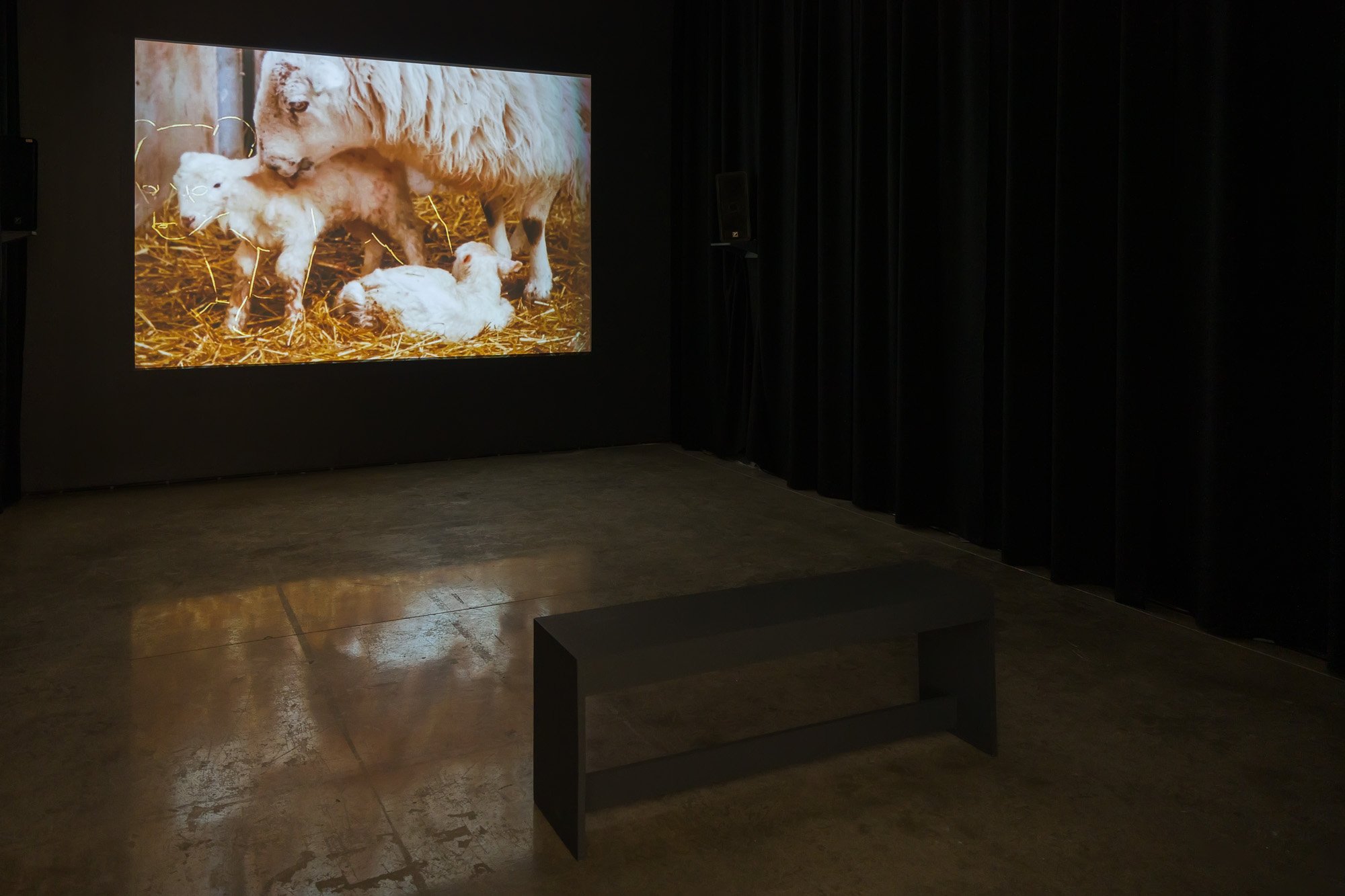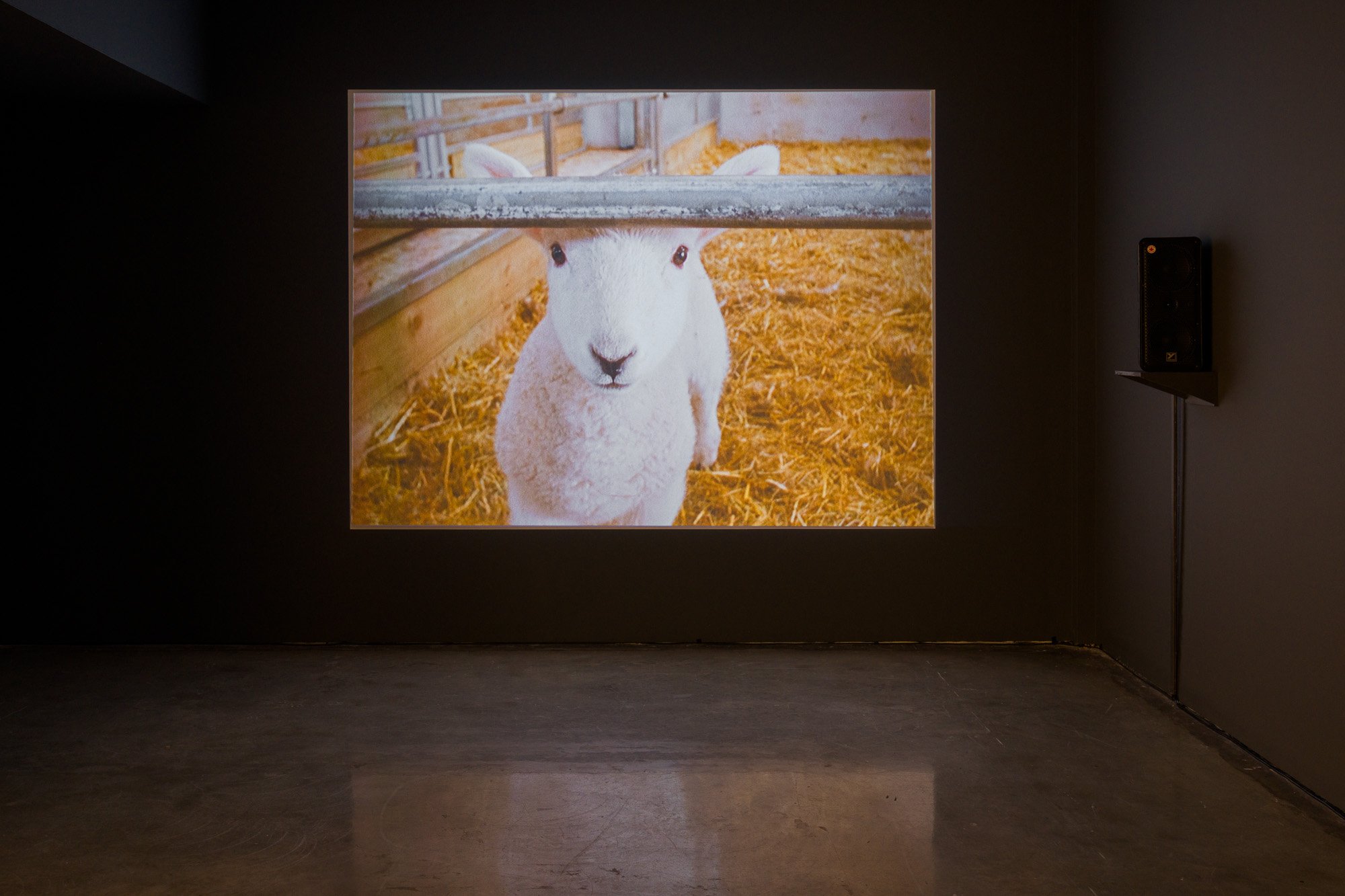Nashashibi/Skaer, Lamb, 16mm film transferred to HD video, 2019. Courtesy of the artist.
FARNESS, THE MORE NEAR / CONSEQUENCES | LUCY SKAER & NASHASHIBI/SKAER
25.09.2021 to 14.11.2021
Opening Reception | September 25 at 7 PM
Anne Carson’s essay Decreation notes the compound term le Loingprès coined by mystic Marguerite Porete (1250-1310) to describe God's unseen presence. Le Loingprès meaning “the FarNear” was used by Porete in describing a connection with a Being whose absence fills the world.
Inside her own telling Marguerite Porete sets up a little ripple of disbelief—a sort of distortion in the glass—as if to remind us that this dream of distance is after all just a dream. At the end of her book she returns to the concept one last time, saying simply: Farness is the more Near.
—Decreation, Anne Carson, p.176
Lucy Skaer’s practice calls others to converse across great distances, generations, and species in a manner reminiscent of the FarNear. The inherent qualities of materials found in her works of wood, bronze, or ceramic, reveal narratives of similarity across those distances. For example, she notes that a line of granite along the Southern Alberta landscape has the same mineral fragments as the beds of granite penetrating the Scottish mountains near her studio. Geological processes are universal and yet, hardly detectable.
This exhibition developed over the past three turbulent years. To reflect these changes, Skaer has given the exhibition a subtitle: Consequences. The second title of this exhibition comes from the surrealist game, where parts of figures are drawn on a paper, folded, and passed between players to form a composite character. The word also has a more direct meaning as the negative result of choices or activity. The works in this show are rooted between these two notions and may be read as a single body made of invented and combined parts.
In the creation stages of this show, many plans were changed due to the pandemic. This constraint fuelled Skaer’s work, perhaps most clearly seen in the companion films Lamb (2019) and Bear (2021). Lamb was shot over the course of several mornings in a farmer’s lambing shed near Skaer’s house in the Outer Hebrides archipelago. Ewes are seen giving birth and tending to their lambs, in a yearly matrilineal drama. Plans to film bears in the Canadian Rockies transformed into filming again in the lambing shed during the 2020 lockdown and drawing bears frame-by-frame over the lambs, as if the lambs and ewes are inhabited by another spirit or species.
Two works in bronze of an enclosure and overlapping animal pelts recall the colonial process of domestication, the taming of land and its inhabitants for material gain. Boundary describes a liminal space, cordoned off from the rest of the gallery. Forest on Fire can be read as a linguistic game, in which words are made into imagined creatures, the creatures are skinned and their pelts lie over one another to form a sentence.
Skaer also visited geographic sites across the Alberta badlands, reflecting on Southern Alberta’s extractive clay industry and land use. Once dug up, clay is refashioned into settler goods and infrastructure like water pipes which once again return to the ground. Skaer’s newest series of ceramic sculptures, Kiln Sleepers, are made from Medalta clay and can be seen as personifications of the material. Many travellers broke their journey at Medicine Hat and slept in the cooling kilns for warmth.
In the Upper Gallery, the film Why Are You Angry? (2017) originates from Skaer's ongoing collaborative practice with Rosalind Nashashibi. Since 2005, Nashashibi/Skaer have produced collaborative films that respond to their exchanges between artistic practices as painter and sculptor. Why Are You Angry? is named after Paul Gaugin's painting No te aha oe riri (Why Are You Angry?) of 1896. Skaer and Nashashibi retrace the French painter's journey to Tahiti over a century later to film women. Originally premiering at documenta 14 in Athens, the film investigates the colonial gaze and asks what it means to represent one another.
Curated by Kristy Trinier and Adam Whitford.
Production assistance provided by the Calgary Zoo.
Lucy Skaer was born in Cambridge, UK, and currently lives and works in Glasgow. She is primarily a sculptor who works across various mediums, including print, film and drawing. Skaer's works often depicts relationships between abstraction and the direct material nature of objects. Many of her works are drawn from historical references which are translated and re-contextualized in new mediums and places. In 2009, Skaer was shortlisted for the Turner Prize, and in 2007, she represented Scotland at the 52nd Venice Biennale.
Rosalind Nashashibi lives and works in London, where she is also a Senior Lecturer at Goldsmiths University. She won the Beck’s Futures prize in 2003, represented Scotland at the Venice Biennale in 2007 and was nominated for the Turner Prize in 2017. That same year, she also participated in documenta 14 in Athens and Kassel. She has recently exhibited at the CAAC, Seville (2019), Secession, Vienna (2018) and Witte de With, Rotterdam (2018).
Nashashibi/Skaer is the joint practice of Rosalind Nashashibi and Lucy Skaer. They have exhibited at Tate, St. Ives (2018), Musée Matisse, Le Cateau Cambrésis (2013), Musée du Château des ducs de Wurtemberg, Montbéliard (2012) and Centro de Arte Dos de Mayo, Madrid (2012). Their films have been screened at documenta 14, Athens and Kassel (2017), KW Institute for Contemporary Art, Berlin (2017), Tate Modern, London (2017) and Tate, St. Ives (2016).
This exhibition was made possible with funding assistance from the Canada Council for the Arts, Alberta Foundation for the Arts, and the City of Lethbridge.













